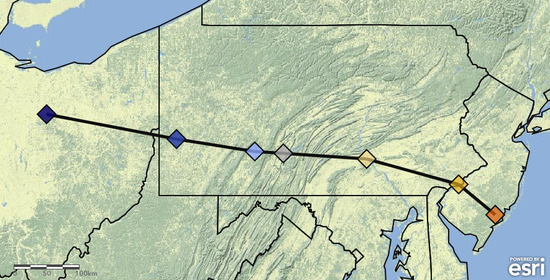Observed Mesoscale Hydroclimate Variability of North America’s Allegheny Mountains at 40.2° N
Abstract
:1. Introduction
2. Materials and Methods
2.1. Transect Physiography
2.2. Data Acquisition
3. Results
3.1. Annual CAT Climate
3.2. CAT Wind Direction
3.3. Ambient CAT Environment
3.4. CAT Precipitation Regimes
4. Discussion
4.1. Annual Climate Oscillations
4.2. CAT Winds
4.3. Long-term CAT Climate
4.4. CAT Precipitation Regimes
4.5. Summary and Future Work
5. Conclusions
Author Contributions
Funding
Acknowledgments
Conflicts of Interest
Appendix A
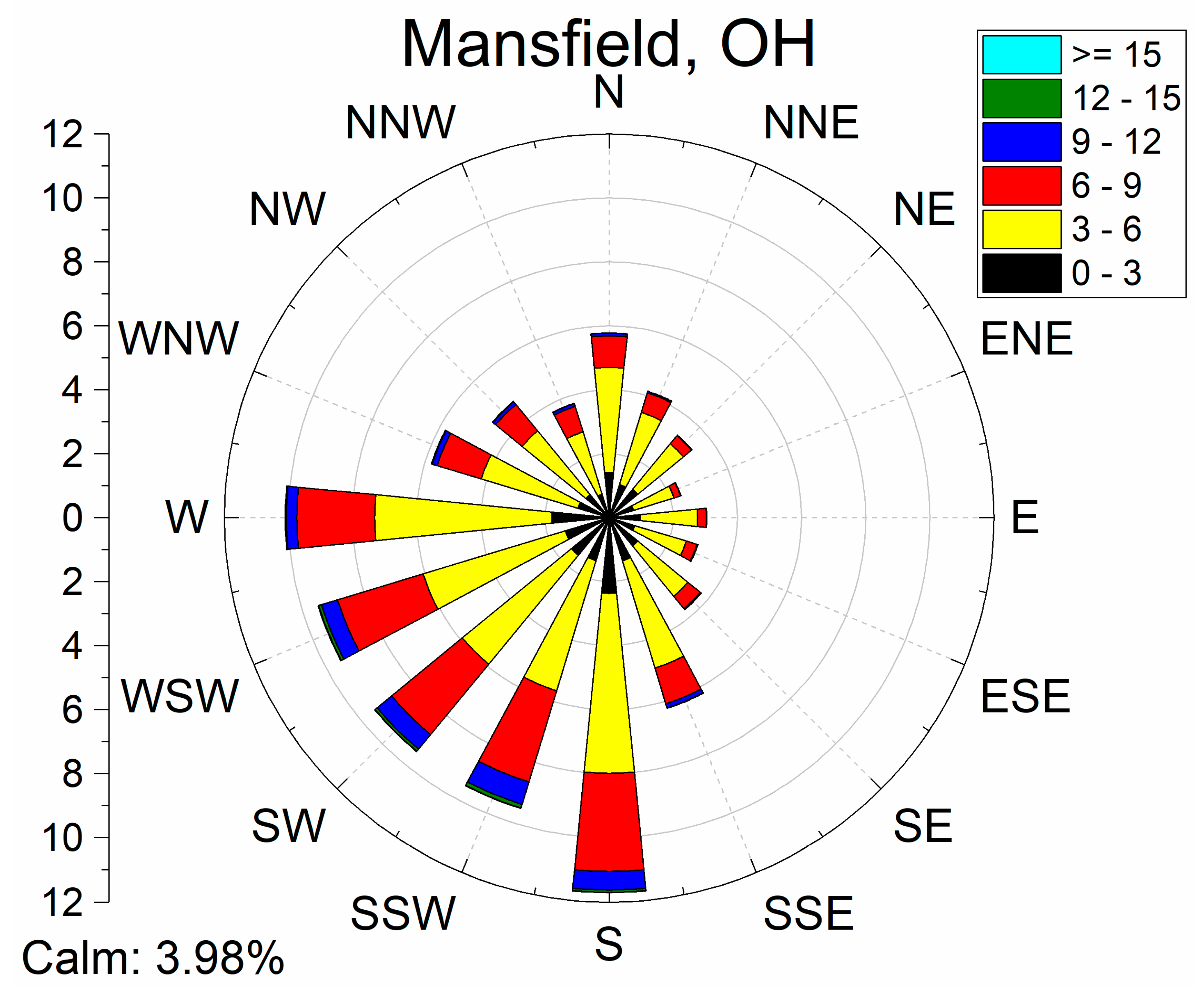
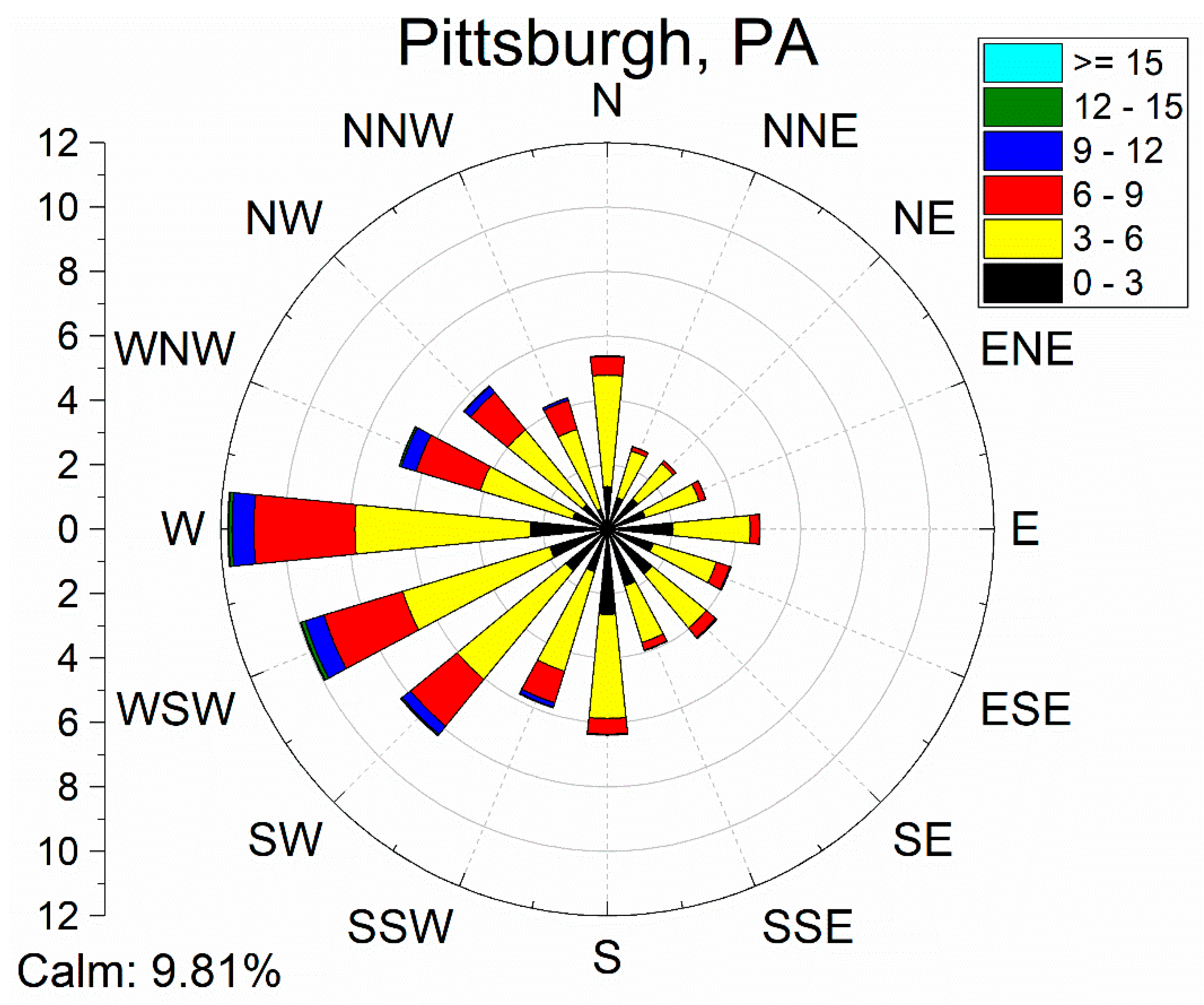
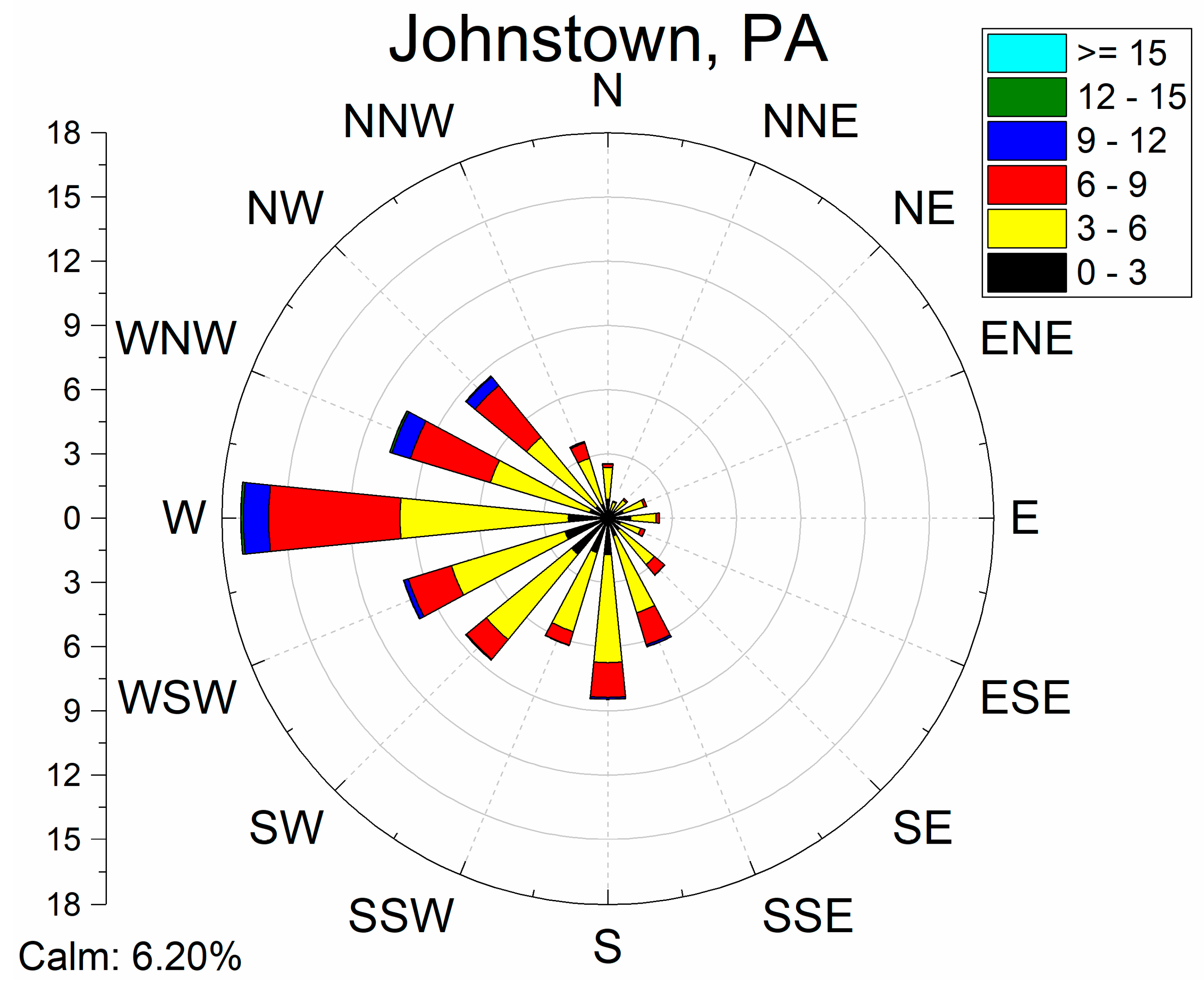
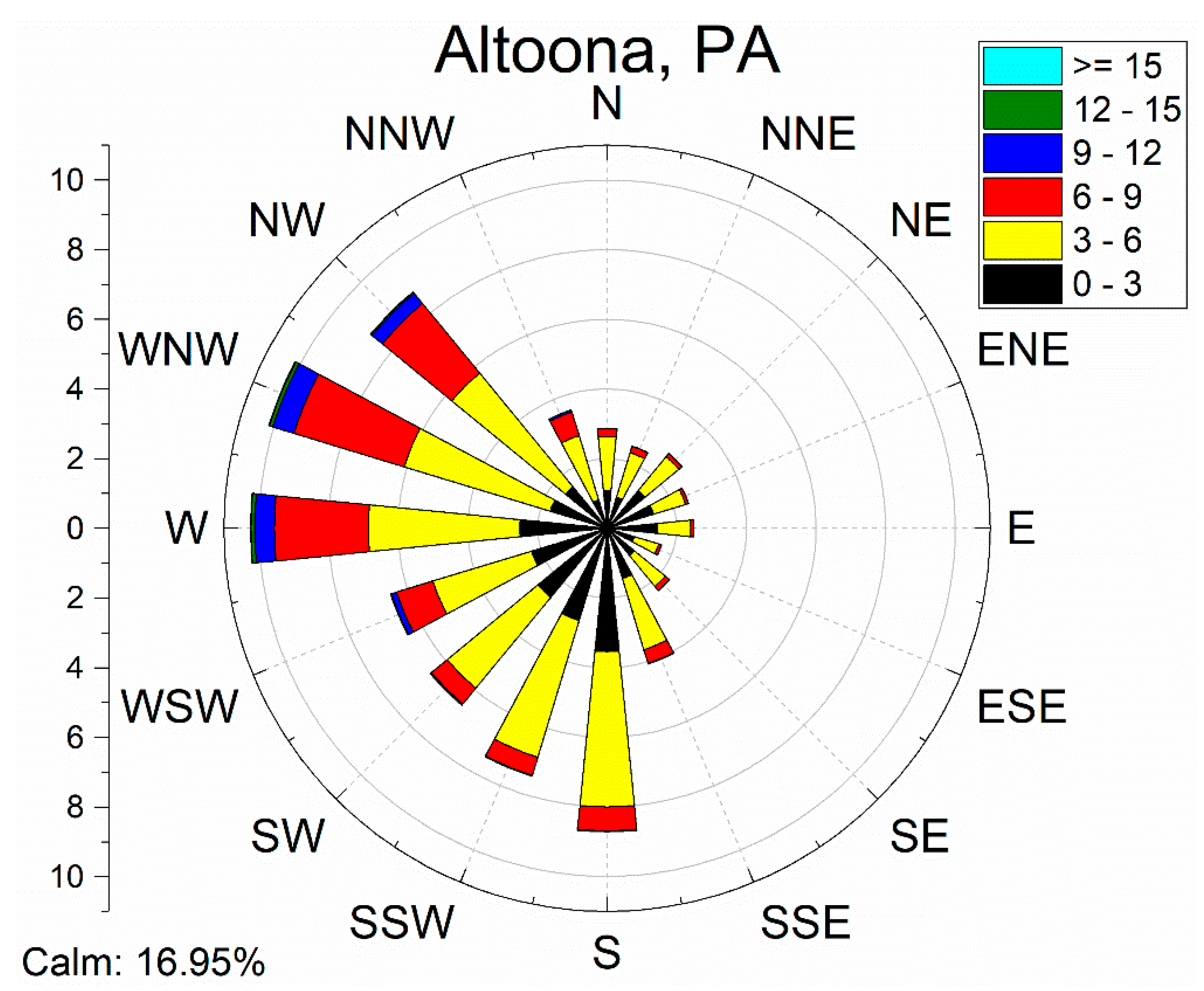
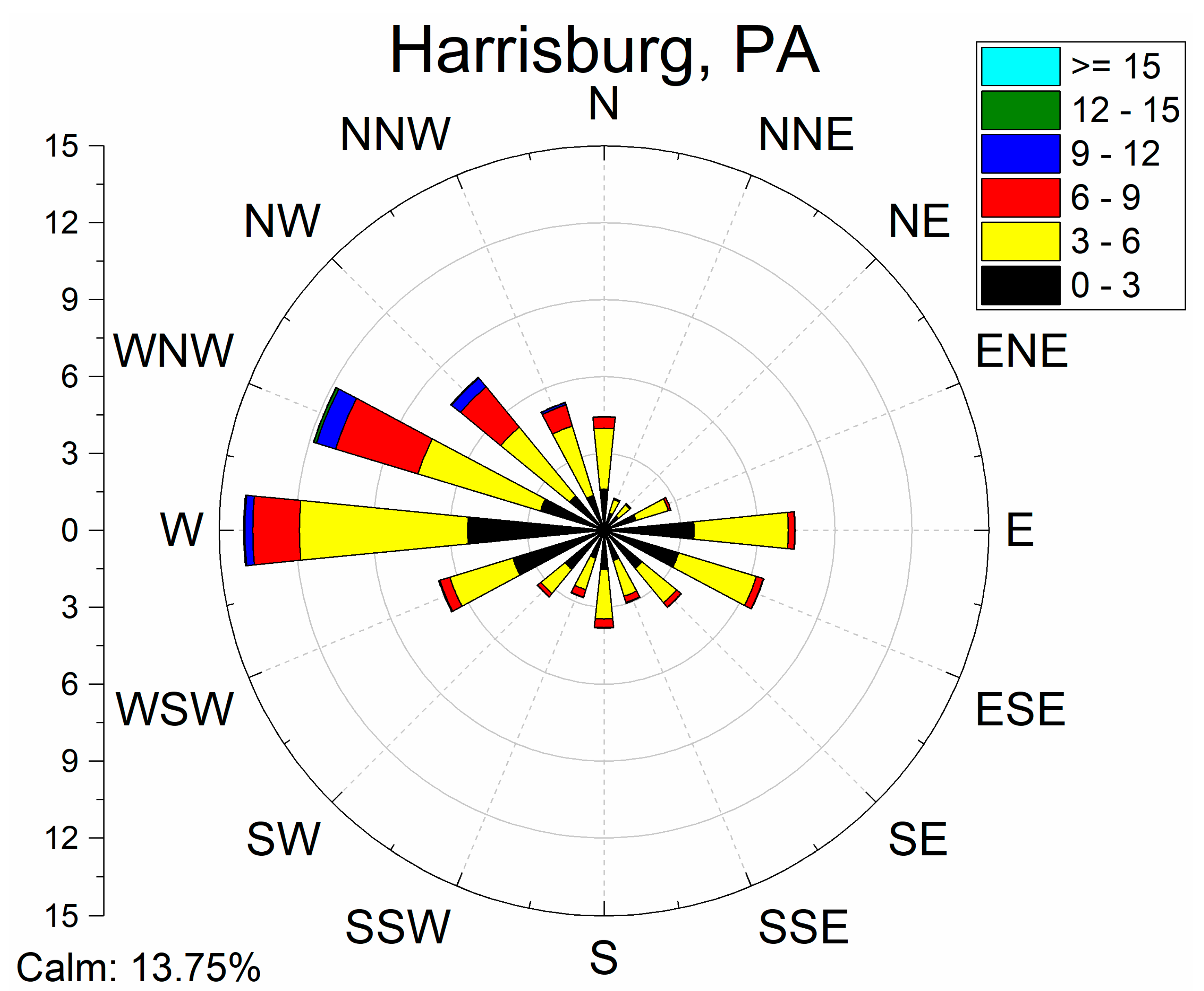
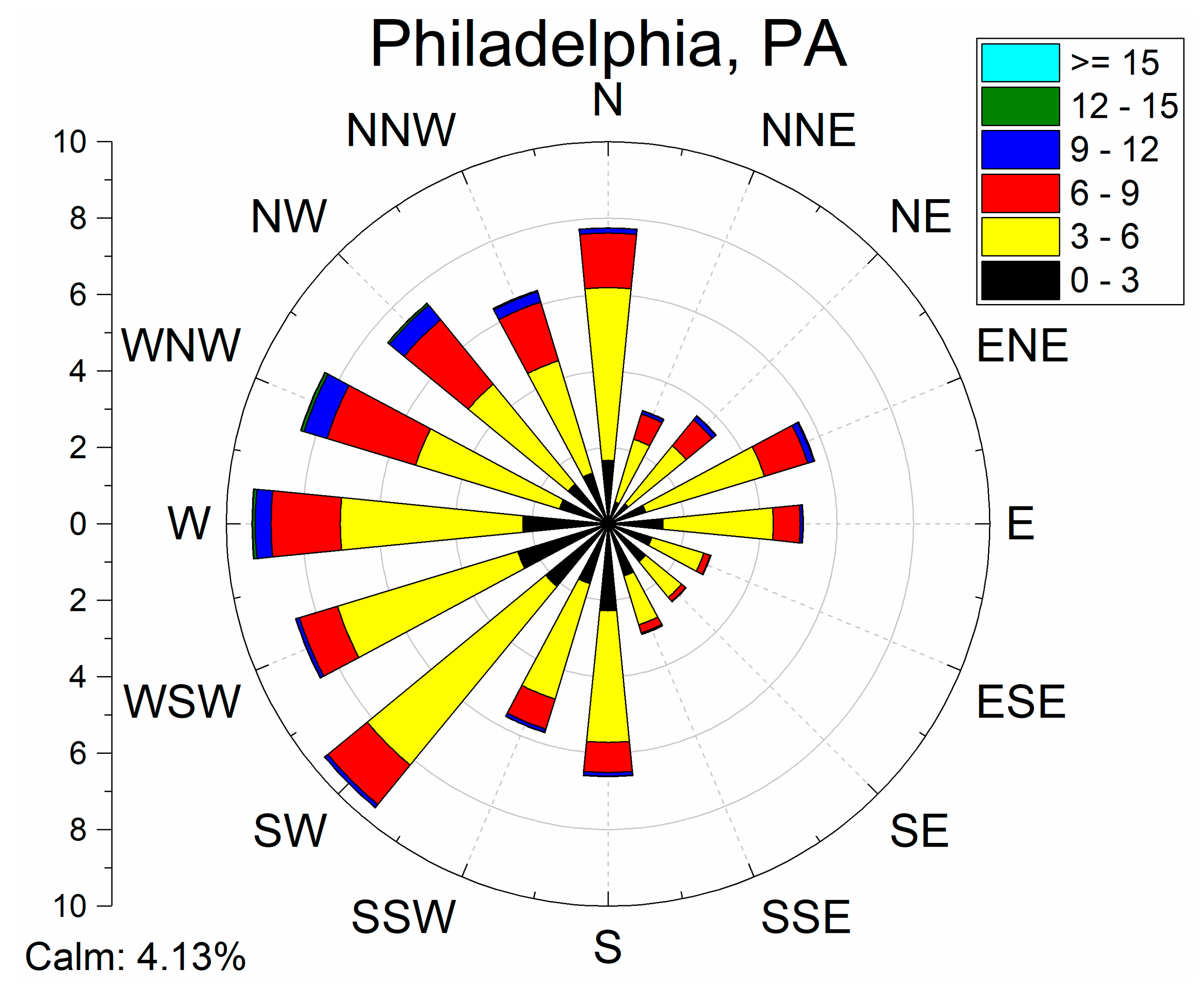

References
- Smith, R.B. The Influence of Mountains on the Atmosphere. Earth 1979, 21, 87–230. [Google Scholar]
- Bell, G.D.; Bosart, L.F. Appalachian cold-air damming. Mon. Weather Rev. 1988, 116, 137–161. [Google Scholar] [CrossRef]
- Warren, R.J., II. An experimental test of well-described vegetation patterns across slope aspects using woodland herb transplants and manipulated abiotic drivers. New Phytol. 2010, 185, 1038–1049. [Google Scholar] [CrossRef] [PubMed]
- Barry, R.G. Mountain Weather and Climate, 3rd ed.; Cambridge University Press: Cambridge, UK, 2008; ISBN 9780511754753. [Google Scholar]
- Müller, H. On the radiation budget in the alps. J. Climatol. 1985, 5, 445–462. [Google Scholar] [CrossRef]
- Katata, G. Fogwater deposition modeling for terrestrial ecosystems: A review of developments and measurements. J. Geophys. Res. 2014, 119, 8137–8159. [Google Scholar] [CrossRef]
- Greenland, D. Spatial distribution of radiation in the Colorado Front Range. Climatol. Bull. 1978, 24, 1–14. [Google Scholar]
- Barry, R.G.; Chorley, R.J. Atmosphere, Weather and Climate; Routledge: Abingdon, UK, 2009. [Google Scholar]
- Houze, R.A., Jr. Orographic effects on precipitating clouds. Rev. Geophys. 2012, 50, 1–47. [Google Scholar] [CrossRef]
- Stockham, A.J.; Schultz, D.M.; Fairman, J.A.A.G.; Draude, A.A.P. Quantifying the rain-shadow effect: Results from the peak district, british isles. Bull. Am. Meteorol. Soc. 2018, 99, 777–790. [Google Scholar] [CrossRef]
- United States Department of Agriculture, F.S. Monongahela National Forest Land and Resource Management Plan. Available online: https://www.fs.usda.gov/Internet/FSE_DOCUMENTS/stelprdb5330420.pdf (accessed on 15 February 2018).
- Rodgers, J. Tectonics of the Appalachians; Wiler-Interscience: New York, NY, USA, 1970. [Google Scholar]
- Richardson, A.D.; Lee, X.; Friedland, A.J. Microclimatology of treeline spruce-fir forests in mountains of the northeastern United States. Agric. For. Meteorol. 2004, 125, 53–66. [Google Scholar] [CrossRef]
- Dickson, R.R. Some Climate-Altitude Relationships in the Southern Appalachian Mountain Region. Bull. Am. Meteorol. Soc. 1959, 40, 352–359. [Google Scholar] [CrossRef]
- Mittelbach, G.G.; Mittelbach, G.G.; Schemske, D.W.; Schemske, D.W.; Cornell, H.V.; Cornell, H.V.; Allen, A.P.; Allen, A.P.; Brown, J.M.; Brown, J.M.; et al. Evolution and the latitudinal diversity gradient: speciation, extinction and biogeography. Ecol. Lett. 2007, 10, 315–331. [Google Scholar] [CrossRef] [PubMed]
- Raitz, K.B.; Ulack, R. Appalachia A Regional Geography Land, People, and Development; Westview Press, Inc.: Boulder, CO, USA, 1984. [Google Scholar]
- Cogbill, A.C.V.; White, P.S. The Latitude-Elevation Relationship for Spruce-Fir Forest and Treeline along the Appalachian Mountain Chain along the Appalachian relationship for spruce-fir mountain chain forest and treeline. Vegetatio 2013, 94, 153–175. [Google Scholar] [CrossRef]
- Smathers, G.A. Fog interception on four southern Appalachian mountain sites. J. Elisha Mitchell Sci. Soc. 1982, 98, 119–129. [Google Scholar]
- Baumgardner, R.E.; Isil, S.S.; Lavery, T.F.; Rogers, C.M.; Mohnen, V.A. Estimates of cloud water deposition at mountain acid deposition program sites in the appalachian mountains. J. Air Waste Manag. Assoc. 2003, 53, 291–308. [Google Scholar] [CrossRef] [PubMed]
- Johnson, D.M.; Smith, W.K. Low clouds and cloud immersion enhance photosynthesis in understory species of a southern Appalachian spruce-fir forest (USA). Am. J. Bot. 2006, 93, 1625–1632. [Google Scholar] [CrossRef]
- Richardson, A.D.; Denny, E.G.; Siccama, T.G.; Lee, X. Evidence for a rising cloud ceiling in eastern North America. J. Clim. 2003, 16, 2093–2098. [Google Scholar] [CrossRef]
- Johnson, D.M.; Smith, W.K. Cloud immersion alters microclimate, photosynthesis and water relations in Rhododendron catawbiense and Abies fraseri seedlings in the southern Appalachian Mountains, USA. Tree Physiol. 2008, 28, 385–392. [Google Scholar] [CrossRef]
- Kunkel, K.E.; Easterling, D.R.; Kristovich, D.A.R.; Gleason, B.; Stoecker, L.; Smith, R. Meteorological Causes of the Secular Variations in Observed Extreme Precipitation Events for the Conterminous United States. J. Hydrometeorol. 2012, 13, 1131–1141. [Google Scholar] [CrossRef]
- Colle, B.A.; Booth, J.F.; Chang, E.K.M. A Review of Historical and Future Changes of Extratropical Cyclones and Associated Impacts Along the US East Coast. Curr. Clim. Chang. Rep. 2015, 1, 125–143. [Google Scholar] [CrossRef] [Green Version]
- Eisenlohr, W.S. Floods of July 18, 1942 in north-central Pennsylvania. In U.S. Geological Survey Water Supply Papers; U.S. G.P.O.: Washington, DC, USA, 1951; pp. 59–158. [Google Scholar]
- Smith, J.A.; Baeck, M.L.; Steiner, M.; Miller, J. Catastrophic rainfall from an upslope thunderstorm in the central Appalachians: The Rapidan storm rainfall accumulations exceeding a 6-h period during the morning and afternoon of Virginia flooding extending from. Water Resour. Res. 1996, 32, 3099–3113. [Google Scholar] [CrossRef]
- Villarini, G.; Steiner, M.; Smith, J.A.; Ntelekos, A.A.; Baeck, M.L. Extreme rainfall and flooding from orographic thunderstorms in the central Appalachians. Water Resour. Res. 2011, 47, 1–24. [Google Scholar]
- Konrad II, C.E. Moisture Trajectories Associated With Heavy Rainfall in the Appalachian Region of the United States. Phys. Geogr. 1994, 15, 227–248. [Google Scholar] [CrossRef]
- Lenderink, G.; Barbero, R.; Loriaux, J.M.; Fowler, H.J. Super-Clausius-Clapeyron scaling of extreme hourly convective precipitation and its relation to large-scale atmospheric conditions. J. Clim. 2017, 30, 6037–6052. [Google Scholar] [CrossRef]
- Kutta, E.; Hubbart, J.A. Changing climatic averages and variance: Implications for mesophication at the eastern edge of North America’s Eastern deciduous forest. Forests 2018, 9. [Google Scholar] [CrossRef]
- Crozier, M.J. Deciphering the effect of climate change on landslide activity: A review. Geomorphology 2010, 124, 260–267. [Google Scholar] [CrossRef]
- Bishop, D.A.; Pederson, N. Regional Variation of Transient Precipitation and Rainless-day Frequency Across a Subcontinental Hydroclimate Gradient. J. Extrem. Events 2015, 2. [Google Scholar] [CrossRef]
- Wilks, D.S. Statistical Methods in the Atmospheric Sciences, 3rd ed.; Academic Press: New York, NY, USA, 2011; ISBN 9780444515544. [Google Scholar]
- DeCarlo L T On the meaning and use of kurtosis. Psychol. Methods 1997, 2, 292–307. [CrossRef]
- Surface Weather Observations and Reports. Federal Meteorological Handbook; National Oceanic and Atmospheric Administration: Washington, DC, USA, 1988; 104p. [Google Scholar]
- Nadolski, V. Automated Surface Observing System User’s Guide. NOAA Publ. 1992, 12, 94. [Google Scholar]
- Nadolski, V.L. Automated Surface Observing System (ASOS) User’s Guide. Natl. Ocean. Atmos. Adm. Dep. Def. Fed. Aviat. Adm. United States Navy 1998, 74. [Google Scholar]
- National Oceanic and Atmospheric Administration Federal Standard for Siting Meteorlogical Sensors at Airports. U.S. Dep. Commer. 1994.
- Fujita, T.T. Tornadoes and downbursts in the context of generalized planetary scales. J. Atmos. Sci. 1981, 38, 1511–1534. [Google Scholar] [CrossRef]
- Annual Estimates of the Resident Population: April 1, 2010 to July 1, 2018; United States Census Bureau: Washington, DC, USA, 2019. Available online: https://factfinder.census.gov/faces/tableservices/jsf/pages/productview.xhtml?src=bkmk (accessed on 25 June 2019).
- Thwaites, F.T. Physiography of Eastern United States. Nevin M. Fenneman, 1st ed.; McGraw-Hill Book Company, Inc.: New York, NY, USA, 2009; Volume 47. [Google Scholar]
- Bothwell, M.P. Incline Planes and People—Some Past and Present Ones. West. Pennsylvania Hist. 1963, 46, 311–346. [Google Scholar]
- Lawther, D.E. Mount Washington: A Demographic Study of the Influence of Changing Technology. West. Pennsylvania Hist. 1981, 64, 44–72. [Google Scholar]
- Renner, G.T. The Physiographic Interpretation of the Fall Line. Geogr. Rev. 1927, 17, 278–286. [Google Scholar] [CrossRef]
- Buck, A.L. New Equations for Computing Vapor Pressure and Enhancement Factor. J. Appl. Meteorol. 1981, 20, 1527–1532. [Google Scholar] [CrossRef] [Green Version]
- Campbell, G.; Norman, J. An Introduction to Environmental Biophysics, 2nd ed.; Springer Science + Business Media, Inc.: New York, NY, USA, 1998; ISBN 0-387-94937-2. [Google Scholar]
- Rose, B.E.J. CLIMLAB: a Python toolkit for interactive, process-oriented climate modeling. J. Open Source Softw. 2018. [Google Scholar]
- Pietruszka, K. GEOCONTEXT-Profiler. Center for Geographic Analysis. 2011. Available online: http://www.geocontext.org/publ/2010/04/profiler/en/ (accessed on 15 March 2018).
- Smothers, R. Fast-Moving Storms Flood Slice of Southern New Jersey. New York Times. 1997. Available online: https://www.nytimes.com/1997/08/22/nyregion/fast-moving-storms-flood-slice-of-southern-new-jersey.html (accessed on 6 June 2018).
- Peixoto, J.P.; Oort, A.H. Physics of Climate; Spring: New York, NY, USA, 1992; ISBN 978-0-88318-712-8. [Google Scholar]
- Evett, S.; Prueger, J.H.; Tolk, J.A. Water and Energy Balances in the Soil-Plant-Atmosphere Continuum; CRC Press: Boca Raton, FL, USA, 2012; ISBN 978-1-4398-0305-9. [Google Scholar]
- Pierrehumbert, R.T. Evidence for Control of Atlantic by Large Scale Advection. Geophys. Res. Lett. 1998, 25, 4537–4540. [Google Scholar] [CrossRef]
- Li, W.; Li, L.; Fu, R.; Deng, Y. Changes to the North Atlantic Subtropical High and Its Role in the Intensification of Summer Rainfall Variability in the Southeastern United States. Bull. Am. 2010. [Google Scholar]
- Diem, J.E. Influences of the Bermuda High and atmospheric moistening on changes in summer rainfall in the Atlanta, Georgia region, USA. Int. J. Climatol. 2012, 33, 160–172. [Google Scholar] [CrossRef]
- Carlson, T.N. Mid-Latitude Weather Systems; Harper Collins Academic: Boston, MA, USA, 1991; ISBN 1-878220-30-6. [Google Scholar]
- Banta, R.M. The role of the mountain flow making clouds. Atmos. Process. Over Complex Terrain 1990, 23, 183–203. [Google Scholar]
- Kochel, R.C. Humid Fans of the Appalachian Mountains. In Alluvial Fans: A Field Approach; Rachocki, A.H., Church, M., Eds.; John Wiley and Sons Ltd.: New York, NY, USA, 1990; pp. 109–129. [Google Scholar]
- Vong, R.J.; Sigmon, J.T.; Mueller, S.F. Cloud Water Deposition to Appalachian Forests. Environ. Sci. Technol. 1991, 25, 1014–1021. [Google Scholar] [CrossRef]
- Lovett, G.M.; Kinsman, J.D. Atmospheric pollutant deposition to high-elevation ecosystems. Atmos. Environ. Part A Gen. Top. 1990, 24, 2767–2786. [Google Scholar] [CrossRef]
- Houze, R.a., Jr. Mesoscale Convective Systems-Review paper. Rev. Geophys. 2004, 42, 1–43. [Google Scholar] [CrossRef]
- Letkewicz, C.E.; Parker, M.D. Forecasting the Maintenance of Mesoscale Convective Systems Crossing the Appalachian Mountains. Weather Forecast. 2010, 25, 1179–1195. [Google Scholar] [CrossRef]
- Goetsch, C.; Wigg, J.; Royo, A.A.; Ristau, T.; Carson, W.P. Chronic over browsing and biodiversity collapse in a forest understory in Pennsylvania: Results from a 60 year-old deer exclusion plot. J. Torrey Bot. Soc. 2011, 138, 220–224. [Google Scholar] [CrossRef]
- Mcewan, R.W.; Dyer, J.M.; Pederson, N. Multiple interacting ecosystem drivers: toward an encompassing hypothesis of oak forest dynamics across eastern North America. Ecography (Cop.) 2011, 34, 244–256. [Google Scholar] [CrossRef]
- O’Handley, C.; Bosart, L.F. The Impact of the Appalachian Mountains on Cyclonic Weather Systems. Part I: A Climatology. Mon. Weather Rev. 1996, 124, 1353–1373. [Google Scholar] [CrossRef] [Green Version]
- Lafon, C.W. Forest disturbance by ice storms in Quercus forests of the southern Appalachian Mountains, USA. Ecoscience 2007, 13, 30–43. [Google Scholar] [CrossRef]
- Forbes, G.S.; Thomson, D.W.; Anthes, R.A. Synoptic and Mesoscale Aspects of an Appalachian Ice Storm Associated with Cold-Air Damming. Mon. Weather Rev. 1987, 115, 564–591. [Google Scholar] [CrossRef] [Green Version]
- Juang, J.-Y.; Stoy, P.; Novick, K.; Katul, G.; Siqueira, M. Separating the effects of albedo from eco-physiological changes on surface temperature along a successional chronosequence in the southeastern United States. Geophys. Res. Lett. 2007, 34. [Google Scholar] [CrossRef] [Green Version]
- Court, A.; Gerston, R.D. Fog Frequency in the United States. Geogr. Rev. 1966, 56, 543–550. [Google Scholar] [CrossRef]
- Mueller, A.S.; Trick, L.M. Driving in fog: The effects of driving experience and visibility on speed compensation and hazard avoidance. Accid. Anal. Prev. 2012, 48, 472–479. [Google Scholar] [CrossRef] [PubMed]
- Parker, M.D. Impacts of Lapse Rates on Low-Level Rotation in Idealized Storms. J. Atmos. Sci. 2011, 69, 538–559. [Google Scholar] [CrossRef]
- Doswell, C.A.; Carbin, G.W.; Brooks, H.E. The tornadoes of spring 2011 in the USA: An historical perspective. Weather 2012, 67, 88–94. [Google Scholar] [CrossRef]
- Folger, P. Severe Thunderstorms and Tornadoes in the United States; DIANE Publishing: Darby, PA, USA, 2013. [Google Scholar]
- Gagan, J.P.; Gerard, A.; Gordon, J. A historical and statistical comparison of “Tornado Alley” to “Dixie Alley”. Natl. Wea. Dig. 2010, 34, 145–155. [Google Scholar]
- Tippett, M.K.; Sobel, A.H.; Camargo, S.J. Association of U. S. tornado occurrence with monthly environmental parameters. Geophys. Res. Lett. 2012, 39, 2–7. [Google Scholar] [CrossRef]
- Gaffin, D.M.; Parker, S.S. A Climatology of Synoptic Conditions Associated with Significant Tornadoes across the. Weather Forecast. 2006, 21, 735–751. [Google Scholar] [CrossRef]
- Agee, E.; Larson, J.; Childs, S.; Marmo, A. Spatial redistribution of U.S. Tornado activity between 1954 and 2013. J. Appl. Meteorol. Climatol. 2016, 55, 1681–1697. [Google Scholar] [CrossRef]
- Bosart, L.F.; Seimon, A.; LaPenta, K.D.; Dickinson, M.J. Supercell Tornadogenesis over Complex Terrain: The Great Barrington, Massachusetts, Tornado on 29 May 1995. Weather Forecast. 2006, 21, 897–922. [Google Scholar] [CrossRef]
- Tippett, M.K.; Allen, J.T.; Gensini, V.A.; Brooks, H.E. Climate and Hazardous Convective Weather. Curr. Clim. Chang. Rep. 2015, 1, 60–73. [Google Scholar] [CrossRef] [Green Version]
- Rohli, R.V.; Vega, A.J. Climatology; Jones and Barttlett Publishers: Sudbury, MA, USA, 2008; ISBN 978-0-7637-3828-0. [Google Scholar]
- Fuller, K.; Shear, H.; Wittig, J. (Eds.) The Great Lakes. An Environmental Atlas and Resource Book, 3rd ed.; United States Environmental Protection Agency: Washington, DC, USA, 1995; ISBN 0-662-23441-3.
- Peet, R.K. Forest vegetation of the Colorado front range. Vegetatio 1981, 45, 3–75. [Google Scholar] [CrossRef]
- Goulden, M.L.; Anderson, R.G.; Bales, R.C.; Kelly, A.E.; Meadows, M.; Winston, G.C. Evapotranspiration along an elevation gradient in California’s Sierra Nevada. J. Geophys. Res. Biogeosciences 2012, 117, 1–13. [Google Scholar] [CrossRef]
- Morin, R.S.; Cook, G.W.; Barnett, C.J.; Butler, B.J.; Crocker, S.J.; Hatfield, M.A.; Kurtz, C.M.; Lister, T.W.; Luppold, W.G.; McWilliams, W.H.; et al. West Virginia Forests 2013. NRS-105. Newt. Square, PA US Dep. Agric. For. Serv. North. Res. Station. 2016, 128, 1–128. [Google Scholar]
- Berry, Z.C.; Hughes, N.M.; Smith, W.K. Cloud immersion: an important water source for spruce and fir saplings in the southern Appalachian Mountains. Oecologia 2014, 174, 319–326. [Google Scholar] [CrossRef] [PubMed]
- Dirmeyer, P.A.; Schlosser, A.C.; Brubaker, K.L. Precipitation, Recycling, and Land Memory: An Integrated Analysis. J. Hydrometeorol. 2009, 10, 278–288. [Google Scholar] [CrossRef]
- Fekedulegn, D.; Hicks, R.R.; Colbert, J.J. Influence of topographic aspect, precipitation and drought on radial growth of four major tree species in an Appalachian watershed. For. Ecol. Manage. 2003, 177, 409–425. [Google Scholar] [CrossRef]
- Thakali, R.; Bhandari, R.; Kandissounon, G.-A.A.; Kalra, A.; Ahmad, S. Flood risk assessment using the updated FEMA floodplain standard in the Ellicott City, Maryland, United States.; World Environmental and Water Resources Congress: Sacramento, CA, USA, 2017; pp. 280–291. [Google Scholar]
- Kopp, G.; Lean, J.L. A new, lower value of total solar irradiance: Evidence and climate significance. Geophys. Res. Lett. 2011, 38. [Google Scholar] [CrossRef] [Green Version]
- Gastineau, G.; Frankignoul, C. Influence of the North Atlantic SST variability on the atmospheric circulation during the twentieth century. J. Clim. 2015, 28, 1396–1416. [Google Scholar] [CrossRef]
- Ruiz-Barradas, A.; Nigam, S. Atmosphere – Land Surface Interactions over the Southern Great Plains: Characterization from Pentad Analysis of DOE ARM Field Observations and NARR. J. Clim. 2013, 26, 875–886. [Google Scholar] [CrossRef]
- Nesbitt, S.W.; Zipser, E.J. The Diurnal Cycle of Rainfall and Convective Intensity according to Three Years of TRMM Measurements. J. Clim. 2003, 16, 1456–1475. [Google Scholar] [CrossRef] [Green Version]
- Jablonowski, C.; Williamson, D.L. A baroclinic instability test case for atmospheric model dynamical cores. Q. J. R. Meteorol. Soc. 2006, 132, 2943–2975. [Google Scholar] [CrossRef] [Green Version]
- Wei, J.; Dirmeyer, P.A. Dissecting soil moisture-precipitation coupling. Geophys. Res. Lett. 2012, 39. [Google Scholar] [CrossRef]
- Francis, J.A.; Vavrus, S.J. Evidence linking Arctic amplification to extreme weather in mid-latitudes. Geophys. Res. Lett. 2012, 39. [Google Scholar] [CrossRef]
- Francis, J.A.; Vavrus, S.J. Evidence for a wavier jet stream in response to rapid Arctic warming. Environ. Res. Lett. 2015, 10, 014005. [Google Scholar] [CrossRef]
- Doswell, C.A.; Brooks, H.E.; Maddox, R.A. Flash Flood Forecasting: An Ingredients-Based Methodology. Weather Forecast. 1996, 11, 560–581. [Google Scholar] [CrossRef]
- Harden, C.P.; Scruggs, P.D. Infiltration on mountain slopes: a comparison of three environments. Geomorphology 2003, 55, 5–24. [Google Scholar] [CrossRef]
- Runkle, J.; Kunkel, K.E.; Frankson, R.; Stewart, B. West Virginia State Climate Summary; 2017; Available online: https://statesummaries.ncics.org/downloads/WV-print-2016.pdf (accessed on 6 June 2018).
- Lavine, M.P. The Johnstown Floods: Causes and Consequences. In Natural and Technological Disasters: Causes, Effects and Preventative Measures.; Majumdar, S.K., Forbes, G.S., Miller, E.W., Schmalz, R.F., Eds.; The Pennsylvania Academy of Science: Phillipsburg, NJ, USA, 1992; pp. 536–542. ISBN 978-0945809067. [Google Scholar]
- Frei, C.; Schär, C. A Precipitation Climatology of the Alps From High-Resolution Rain-Gauge Observations. Int. J. Climatol. 1998, 18, 873–900. [Google Scholar] [CrossRef]
- Mueller, C.K.; Carbone, R.E. Dynamics of a Thunderstorm Outflow. J. Atmos. Sci. 1986, 44, 1879–1898. [Google Scholar] [CrossRef]
- Moncrieff, M.W.; Liu, C. Convection Initiation by Density Currents: Role of Convergence, Shear, and Dynamical Organization. Mon. Weather Rev. 1999, 127, 2455–2464. [Google Scholar] [CrossRef]
- Moncrieff, M.W. The Multiscale Organization of Moist Convection and the Intersection of Weather and Climate. Geophys. Monogr. Ser. 2010, 189, 3–26. [Google Scholar]
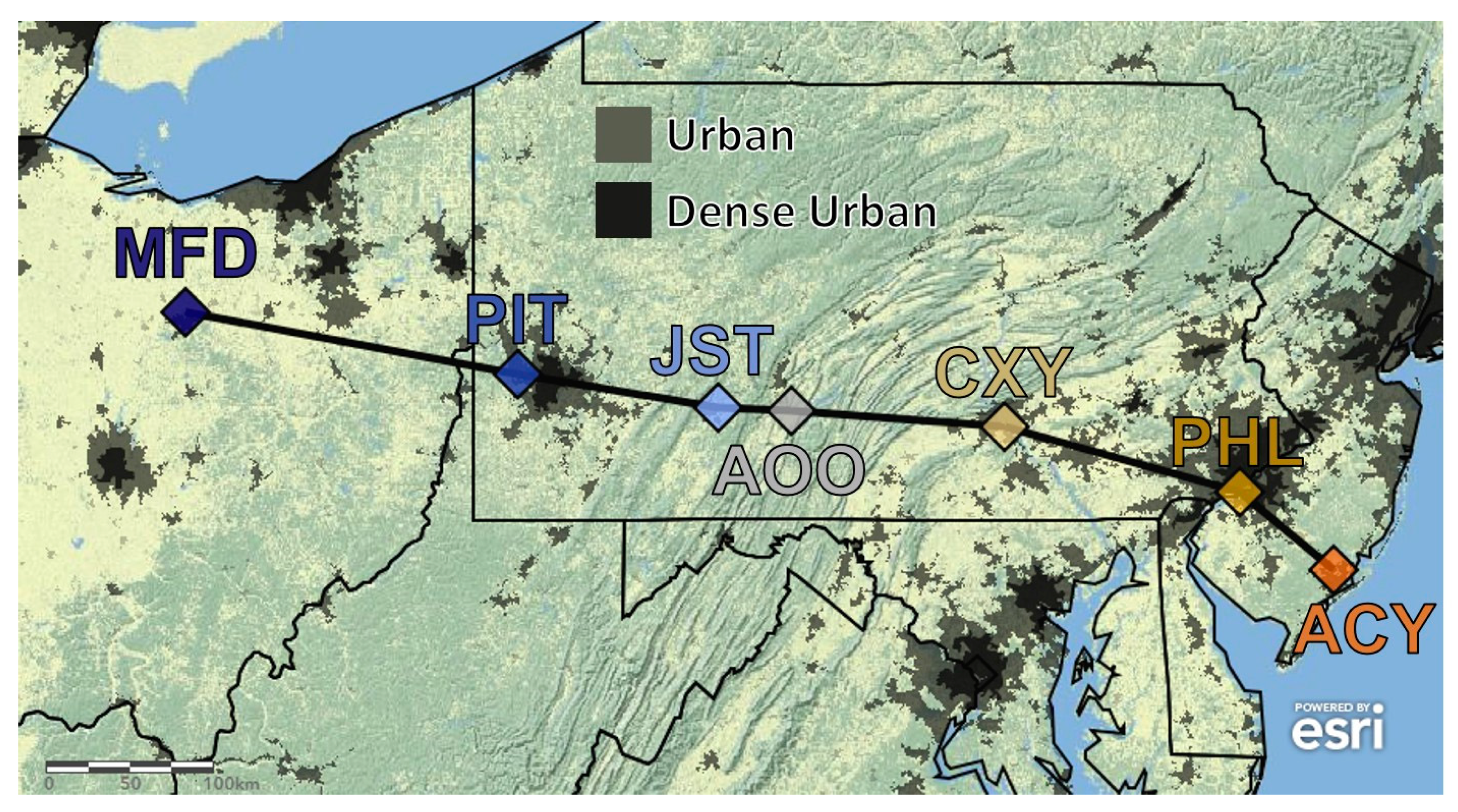
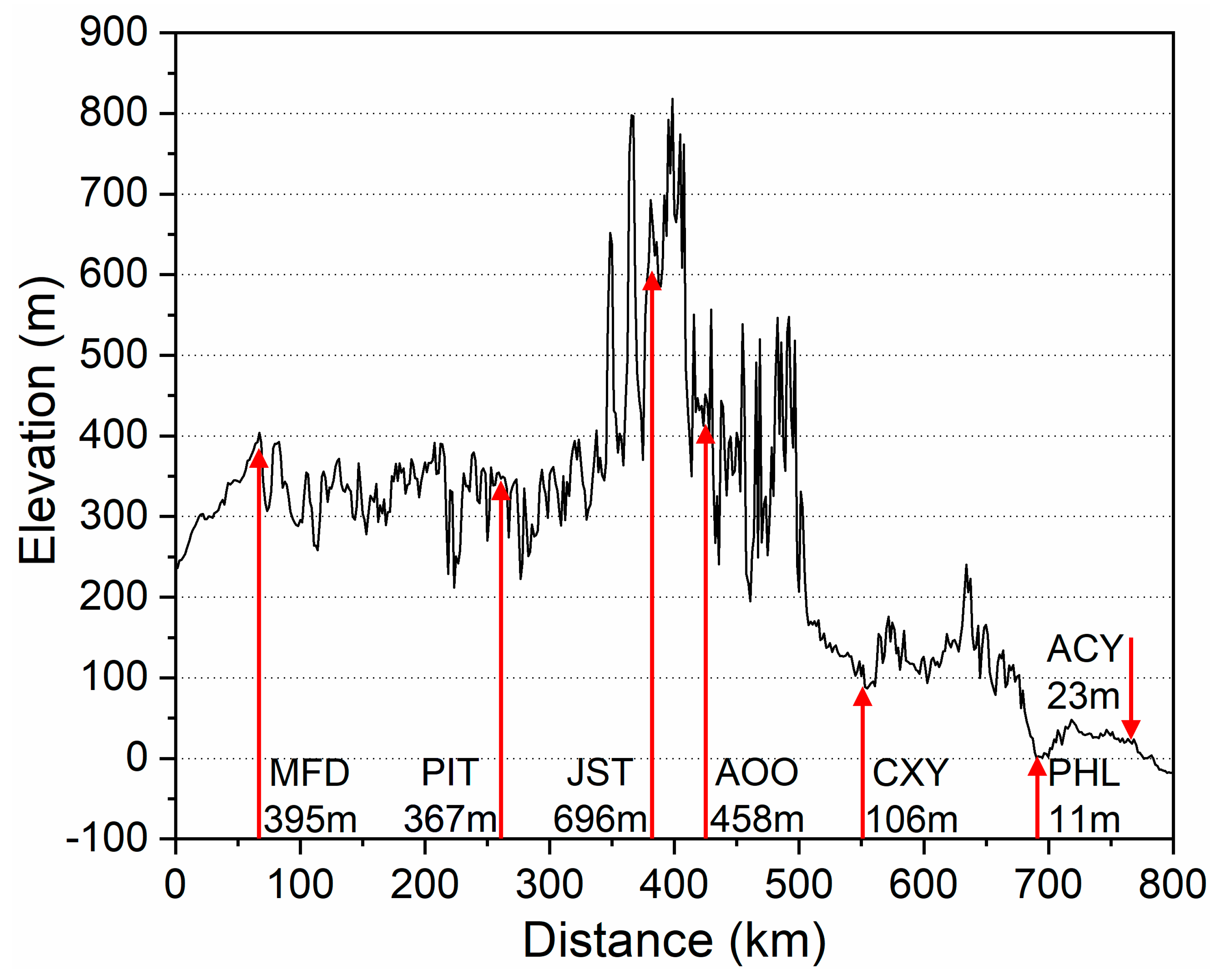
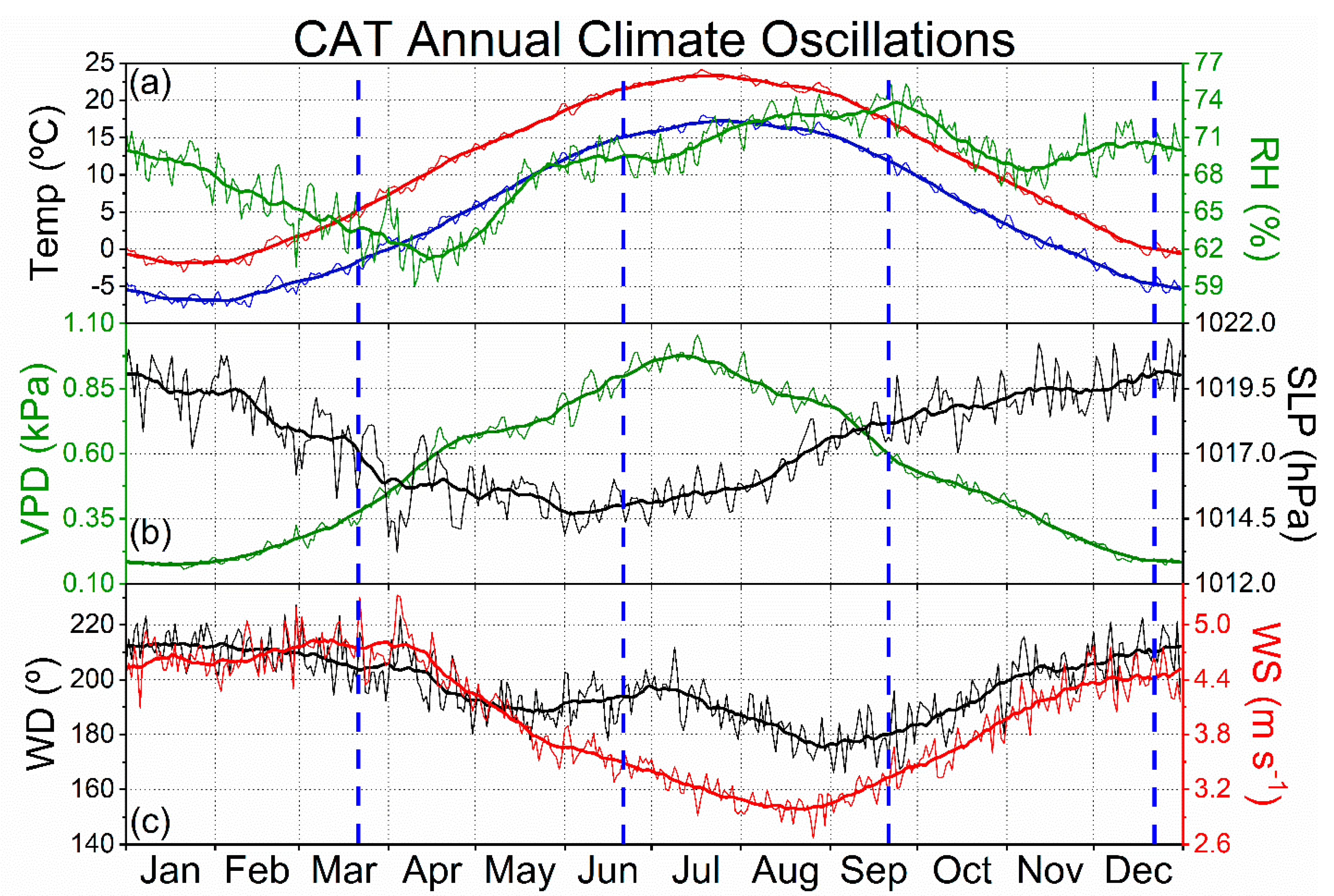
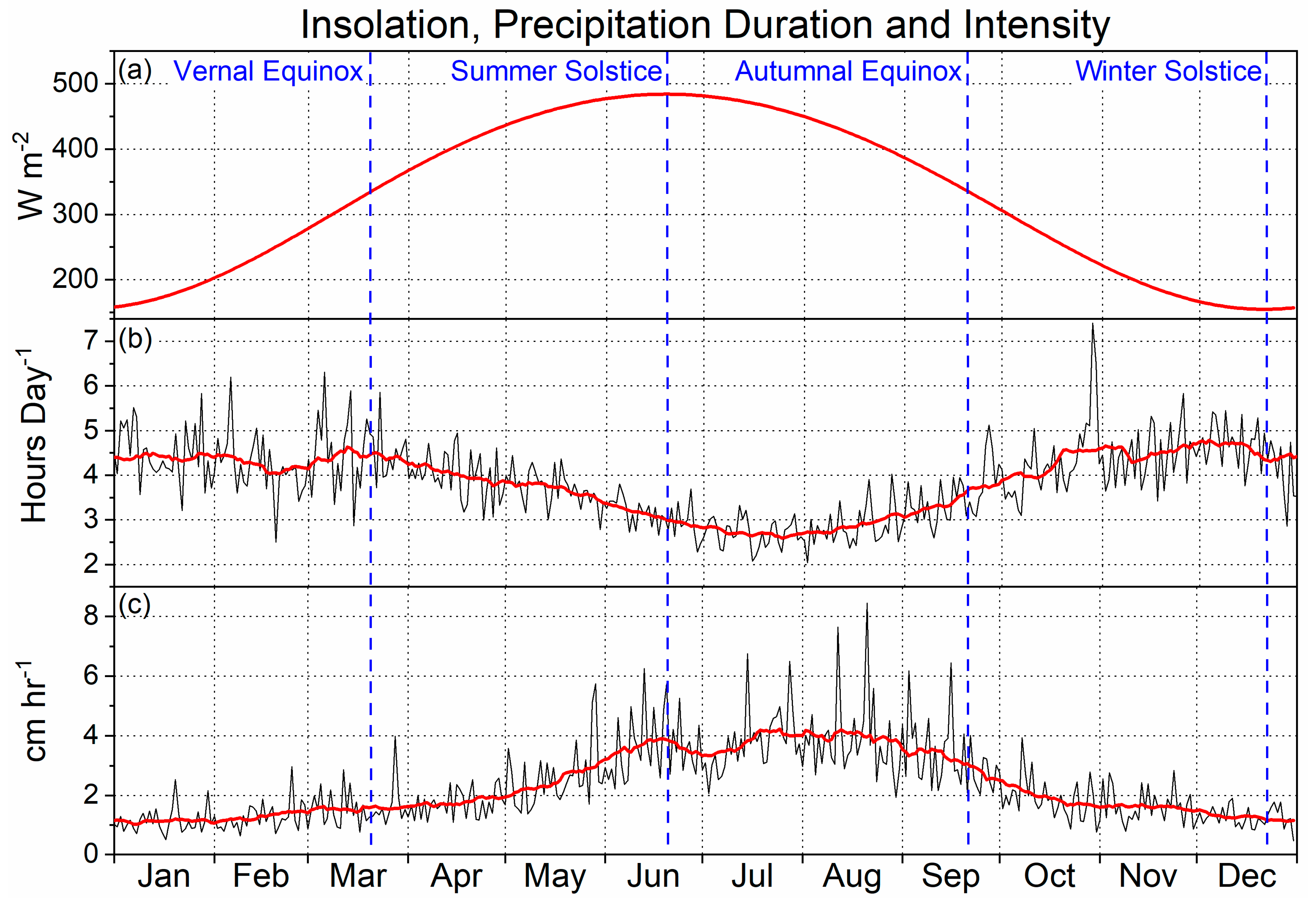
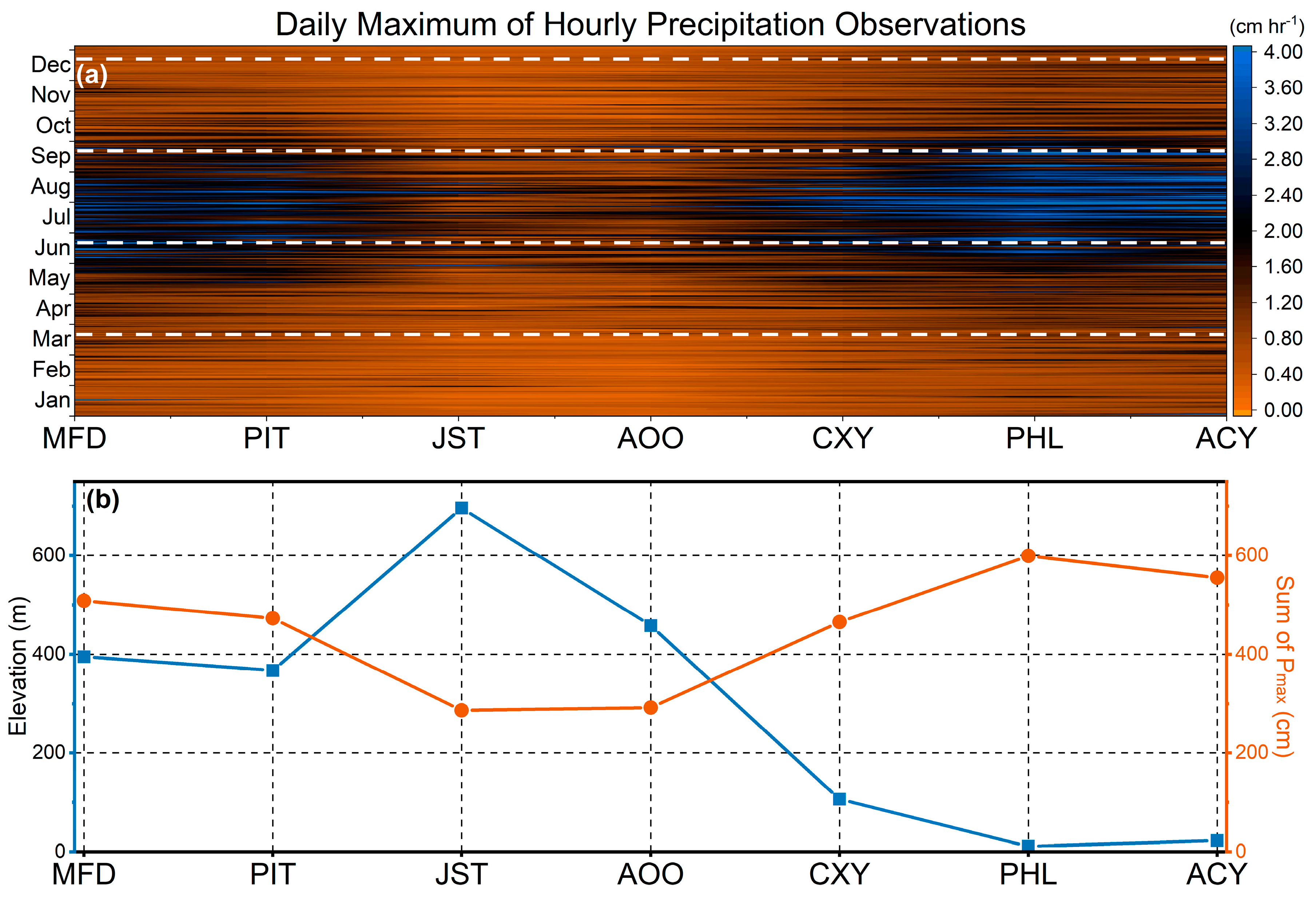
| Latitude | Longitude | Elevation | P.O.R. | Observations | |
|---|---|---|---|---|---|
| Mansfield (MFD) | 40.82° N | 82.52° W | 395 m | 1948–2017 1 | 437,882 |
| Pittsburgh (PIT) | 40.49° N | 80.23° W | 367 m | 1949–2017 | 571,954 |
| Johnstown (JST) | 40.32° N | 78.83° W | 696 m | 1973–2017 * | 316,120 |
| Altoona (AOO) | 40.30° N | 78.32° W | 458 m | 1949–2017 * 2 | 420,066 |
| Harrisburg (CXY) | 40.22° N | 76.85° W | 106 m | 1948–2017 3 | 516,210 |
| Philadelphia (PHL) | 39.87° N | 75.24° W | 11 m | 1948–2017 | 608,283 |
| Atlantic City (ACY) | 39.46° N | 74.58° W | 23m | 1948–2017 | 555,004 |
| Heading (°) | MFD | PIT | JST | AOO | CXY | PHL | ACY | Avg CAT | |
|---|---|---|---|---|---|---|---|---|---|
| Calm | 4.0 | 9.8 | 6.2 | 17.0 | 13.8 | 4.1 | 7.8 | 9.0 | |
| NNE | 22.5 | 4.1 | 2.7 | 0.8 | 2.5 | 1.3 | 3.1 | 3.3 | 2.5 |
| NE | 45 | 3.4 | 2.8 | 1.2 | 2.8 | 1.4 | 3.7 | 3.2 | 2.6 |
| ENE | 67.5 | 2.3 | 3.2 | 1.9 | 2.4 | 2.7 | 5.7 | 4.0 | 3.2 |
| E | 90 | 3.0 | 4.7 | 2.4 | 2.5 | 7.5 | 5.1 | 4.3 | 4.2 |
| ESE | 112.5 | 2.9 | 4.0 | 1.8 | 1.6 | 6.5 | 2.8 | 3.1 | 3.2 |
| SE | 135 | 3.7 | 4.4 | 3.5 | 2.3 | 3.9 | 2.6 | 2.7 | 3.3 |
| SSE | 157.5 | 6.2 | 3.9 | 6.3 | 4.1 | 3.0 | 3.0 | 4.3 | 4.4 |
| S | 180 | 11.7 | 6.4 | 8.5 | 8.7 | 3.8 | 6.6 | 9.9 | 7.9 |
| SSW | 202.5 | 9.5 | 5.8 | 6.2 | 7.4 | 2.8 | 5.7 | 7.1 | 6.4 |
| SW | 225 | 9.5 | 8.3 | 8.6 | 6.6 | 3.4 | 9.6 | 5.7 | 7.4 |
| WSW | 247.5 | 9.5 | 10.0 | 10.0 | 6.5 | 6.7 | 8.6 | 6.4 | 8.2 |
| W | 270 | 10.1 | 11.8 | 17.1 | 10.2 | 14.1 | 9.3 | 9.3 | 11.7 |
| WNW | 292.5 | 5.8 | 6.8 | 10.6 | 10.2 | 11.8 | 8.4 | 8.9 | 8.9 |
| NW | 315 | 4.7 | 5.8 | 8.6 | 8.8 | 7.7 | 7.5 | 7.4 | 7.2 |
| NNW | 337.5 | 3.7 | 4.3 | 3.8 | 3.6 | 5.2 | 6.4 | 6.1 | 4.7 |
| N | 360 | 5.8 | 5.4 | 2.5 | 2.9 | 4.4 | 7.8 | 6.5 | 5.0 |
| City | Min | Med | Mean | Max | IQR | St Dev | Skew | Kurt | |
|---|---|---|---|---|---|---|---|---|---|
| Ambient Temp (°C) | MFD | −30.0 | 11.1 | 10.2 | 38.3 | 18.3 | 11.0 | −0.23 | −0.77 |
| PIT | −29.4 | 11.7 | 10.7 | 38.9 | 17.2 | 10.7 | −0.22 | −0.74 | |
| JST | −27.7 | 10.0 | 9.2 | 36.7 | 17.4 | 10.6 | −0.26 | −0.80 | |
| AOO | −31.2 | 10.6 | 10.2 | 38.9 | 17.1 | 10.3 | −0.16 | −0.79 | |
| CXY | −26.2 | 12.2 | 12.0 | 40.6 | 17.3 | 10.4 | −0.09 | −0.86 | |
| PHL | −21.7 | 13.3 | 12.9 | 40.0 | 16.7 | 10.2 | −0.12 | −0.85 | |
| ACY | −23.3 | 12.8 | 12.4 | 39.4 | 16.2 | 10.0 | −0.16 | −0.71 | |
| Dew Point Temp (°C) | MFD | −37.1 | 5.6 | 4.9 | 27.2 | 16.1 | 10.2 | −0.28 | −0.70 |
| PIT | −35.0 | 5.0 | 4.6 | 26.8 | 16.6 | 10.1 | −0.29 | −0.76 | |
| JST | −34.3 | 4.0 | 3.8 | 27.0 | 16.1 | 10.0 | −0.26 | −0.82 | |
| AOO | −35.6 | 4.4 | 4.4 | 26.7 | 16.6 | 10.1 | −0.25 | −0.84 | |
| CXY | −33.3 | 5.0 | 5.0 | 28.9 | 17.6 | 10.6 | −0.24 | −0.84 | |
| PHL | −32.2 | 6.7 | 6.1 | 28.3 | 17.2 | 10.6 | −0.32 | −0.76 | |
| ACY | −30.6 | 7.8 | 6.8 | 28.3 | 16.7 | 10.4 | −0.35 | −0.72 | |
| Relative Humidity (%) | MFD | 4.1 | 73.7 | 71.8 | 100.0 | 28.1 | 18.0 | −0.40 | −0.67 |
| PIT | 4.7 | 69.5 | 67.8 | 100.0 | 28.9 | 18.5 | −0.35 | −0.72 | |
| JST | 6.8 | 73.3 | 70.9 | 100.0 | 29.2 | 18.6 | −0.47 | −0.59 | |
| AOO | 6.0 | 70.1 | 68.8 | 100.0 | 28.8 | 18.7 | −0.30 | −0.71 | |
| CXY | 5.5 | 64.8 | 64.6 | 100.0 | 34.3 | 20.5 | −0.13 | −0.99 | |
| PHL | 7.8 | 65.6 | 65.2 | 100.0 | 33.7 | 20.1 | −0.14 | −1.00 | |
| ACY | 7.3 | 73.9 | 70.9 | 100.0 | 33.2 | 20.0 | −0.45 | −0.81 | |
| VPD (kPa) | MFD | 0.00 | 0.26 | 0.49 | 4.56 | 0.58 | 0.55 | 1.72 | 2.93 |
| PIT | 0.00 | 0.32 | 0.54 | 5.42 | 0.59 | 0.57 | 1.75 | 3.07 | |
| JST | 0.00 | 0.27 | 0.45 | 4.83 | 0.53 | 0.48 | 1.75 | 3.41 | |
| AOO | 0.00 | 0.29 | 0.49 | 5.32 | 0.52 | 0.52 | 1.91 | 4.13 | |
| CXY | 0.00 | 0.38 | 0.62 | 5.92 | 0.64 | 0.63 | 1.85 | 3.86 | |
| PHL | 0.00 | 0.40 | 0.63 | 5.71 | 0.63 | 0.63 | 1.77 | 3.34 | |
| ACY | 0.00 | 0.30 | 0.51 | 5.37 | 0.54 | 0.56 | 2.03 | 4.79 |
| n | Min | Med | Mean | Max | IQR | St Dev | Skew | Kurt | |
|---|---|---|---|---|---|---|---|---|---|
| MFD | 34778 | 0.03 | 0.05 | 0.15 | 8.00 | 0.13 | 0.26 | 6.59 | 82.22 |
| PIT | 44764 | 0.03 | 0.05 | 0.13 | 5.44 | 0.10 | 0.22 | 6.43 | 68.78 |
| JST | 13538 | 0.03 | 0.05 | 0.13 | 5.11 | 0.13 | 0.22 | 6.62 | 79.62 |
| AOO | 11693 | 0.03 | 0.08 | 0.14 | 4.60 | 0.13 | 0.22 | 5.78 | 56.46 |
| CXY | 30982 | 0.03 | 0.08 | 0.15 | 7.65 | 0.15 | 0.24 | 6.40 | 79.62 |
| PHL | 42667 | 0.03 | 0.08 | 0.17 | 6.50 | 0.18 | 0.28 | 6.03 | 60.79 |
| ACY | 32678 | 0.03 | 0.08 | 0.18 | 8.46 | 0.18 | 0.28 | 6.85 | 94.20 |
| Maximum | 366 | 0.46 | 1.94 | 2.31 | 8.46 | 1.75 | 1.31 | 1.28 | 2.02 |
| Duration | 366 | 2.04 | 3.85 | 3.85 | 7.41 | 1.24 | 0.86 | 0.37 | 0.23 |
© 2019 by the authors. Licensee MDPI, Basel, Switzerland. This article is an open access article distributed under the terms and conditions of the Creative Commons Attribution (CC BY) license (http://creativecommons.org/licenses/by/4.0/).
Share and Cite
Kutta, E.; Hubbart, J. Observed Mesoscale Hydroclimate Variability of North America’s Allegheny Mountains at 40.2° N. Climate 2019, 7, 91. https://doi.org/10.3390/cli7070091
Kutta E, Hubbart J. Observed Mesoscale Hydroclimate Variability of North America’s Allegheny Mountains at 40.2° N. Climate. 2019; 7(7):91. https://doi.org/10.3390/cli7070091
Chicago/Turabian StyleKutta, Evan, and Jason Hubbart. 2019. "Observed Mesoscale Hydroclimate Variability of North America’s Allegheny Mountains at 40.2° N" Climate 7, no. 7: 91. https://doi.org/10.3390/cli7070091




